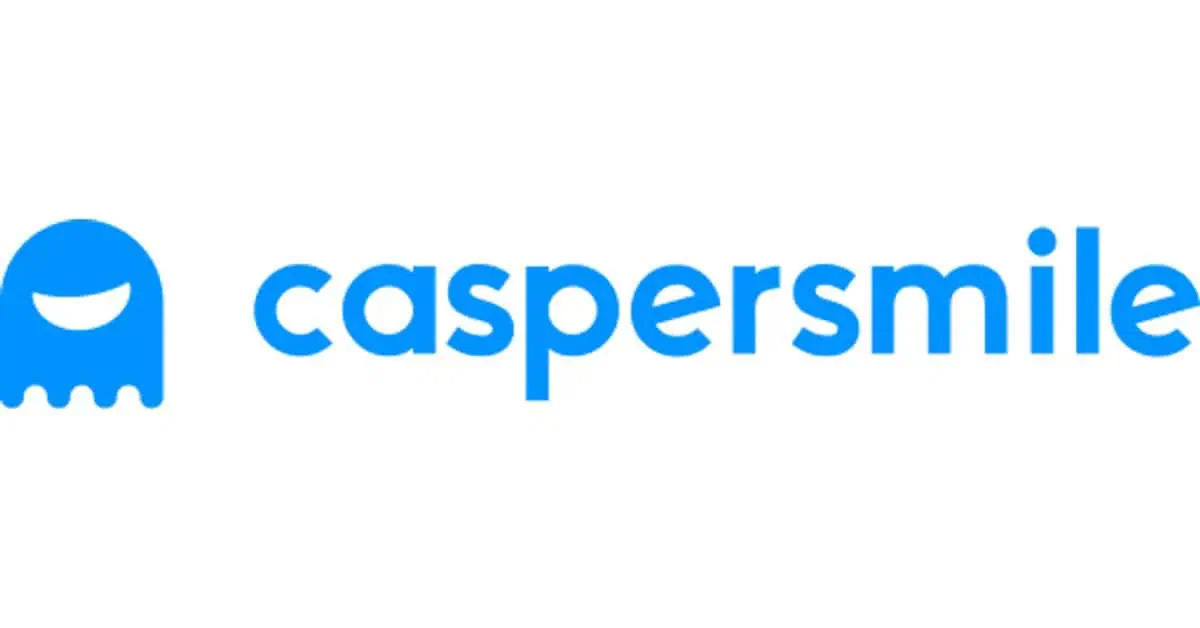An underbite occurs when the lower teeth sit further forward than the upper teeth. This condition is often genetic, and underbite correction is usually recommended to avoid problems later in life.
It is possible to fix an underbite in adults and children; surgery and dental braces are common treatment options, along with some others. Here, we’ll talk you through everything that you need to know about this type of dental malocclusion and how it may affect you or your child.
What is an underbite?
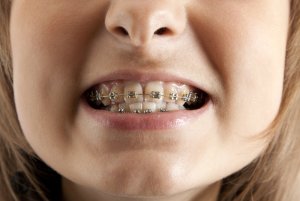
An underbite occurs when the lower jaw sits further forward than the upper jaw, causing the lower front teeth to stick out. This condition occurs in around 5-10% of the population.
In lots of people an underbite jaw is barely noticeable, with the lower teeth resting just slightly in front of the upper teeth. In more severe cases, there can be a very noticeable gap between the sets of teeth. No matter the severity of the bite misalignment, underbite correction is generally recommended because of the problems it can lead to if untreated.
What causes an underbite?
Most cases of underbite teeth are genetic in origin; if at least one parent has (or had) an underbite then the chances of their children having an underbite increases. The condition is linked to cleft lips and palates, and the following childhood behaviours are also potential underbite causes:
- Thumb sucking
- Tongue thrusting
- Overuse of a dummy
- Bottle feeding for too long
It may be that the upper jaw is to short and hasn’t developed properly or the lower jaw protrudes too far – or a combination of the two.
Do I need underbite correction?
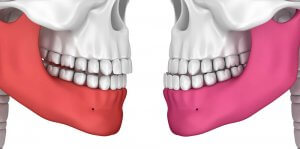
If your child or baby has an underbite, it is best to start treatment early, when their bones are more easily moved. Without treatment, there are lots of potential problems your child could face.
One of the big differences between an underbite and overbite is that some small overbite is natural, whereas no kind of underbite is considered ‘normal’. There are lots of problems that come along with having underbite teeth, and the longer you wait to correct them the harder the treatment may be. Problems can include:
- Problems with biting and chewing food properly
- Speech issues such as slurring and lisping
- Facial pain because of abnormal strain or pressure on the jaw
- Increased chances of childhood tooth decay
- Worn down tooth enamel and cracked teeth
- A differently shaped face than normal
- Sleep apnea
- Mouth breathing
- Lower self esteem
Here, Dr Chang talks through the problems that children can experience with underbite teeth, and why early intervention is important:
How to fix an underbite
There are a number of ways that have been developed to successfully fix an underbite. Your dentist will explain the best dental care for your situation, but below you can find an overview of the most common treatment options.
Usually, two or more of these treatments will be combined to provide the most effective, long-term solution for you, your child, or your baby with an underbite.
An underbite occurs when the lower teeth and jaw extend outward farther than the upper front teeth. When left untreated, the condition can create a host of problems – both cosmetic and functional – and it can also lead to a number of dental and health concerns.
A severe underbite can change the look of a person’s face and can even make them look upset or angry when they really aren’t.
Having an underbite also means your jaw can’t function the way it should, which may cause issues with speech, chewing and swallowing. In addition, your individual teeth may be damaged by improper contact due to the underbite.
Correction of an underbite can be a complex issue, but there are great treatment options available. The orthodontist is usually the best place to start.
Once corrected, you will feel less stress on your teeth, jaws and facial muscles, and will love the change in your smile and bite function.
Dr. Greg Nalchajian, Nalchajian Orthodontics
Upper jaw expander
In cases where an underbite jaw is caused by the upper jaw not developing fully, a jaw expander helps it develop to the correct shape. This is a metal device that fits over the back teeth. It gradually pushes out the teeth and expands the palate. Some devices are removable, like a retainer, while others are fixed orthodontic treatments.
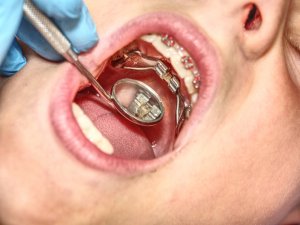
This is one of the least noticeable forms of underbite correction; unless you laugh or yawn, nobody is likely to see the top of your mouth or back teeth where it sits. People who have used a jaw or palate expander say that it can be painful, but some discomfort is expected when you are manipulating the jaw bone. Since jaw bones don’t fuse until around age 12 or 13, starting this treatment at a young age will make things a little bit easier.
A jaw expander is normally used for around one year, but it depends on how much teeth movement is required. Once the treatment is complete, patients have to wear a retainer for a while so that new bone can grow, making the overbite correction permanent.
Reverse pull headgear
Another method of underbite correction is a reverse pull face mask or headgear. This sounds quite scary, but is it a normal way to fix an underbite. The headgear rests on the forehead and chin and attaches to braces or a retainer using elastic bands to pull the upper teeth slowly into position.
A study has shown this method of underbite treatment to be up to 75% effective overall, even more so if treatment is started before the age of ten.
The headgear may be used in conjunction with a chin cap or cup. This device fits over the head, from the crown to the chin, and is designed to reduce the growth of the lower jaw, helping the upper and lower teeth become aligned more quickly.
To get the most benefit, the device should be worn as often as possible; certainly every night, and perhaps even during the day. Your child may not mind wearing it while watching TV or doing homework, but wearing it to school and social events is another matter. Still, you should follow your orthodontist’s advice, because correct use should reduce the need for underbite surgery later on.
Underbite braces
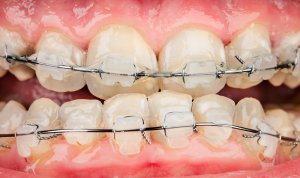
Along with the methods mentioned above, braces are normally part of underbite treatment. As with orthodontic treatment for other problems, such as overbite, crossbite and open bite, underbite braces will twist, push, and move your teeth into a better alignment.
If you or your child are treated as an NHS patient, only metal braces will be offered. As a private patient, however, you will have the option of other, less noticeable orthodontic treatments such as clear braces (pictured).
After treatment for underbite with braces, you will need to wear a retainer to maintain the progress you have made.
The following timelapse shows how underbite treatment with braces (and no surgery) is possible:
Invisalign for underbite correction
It’s also possible to use Invisalign aligners for an underbite in many cases. These clear aligners are almost invisible, making them a popular option for people who don’t want it to be obvious that they are wearing braces.
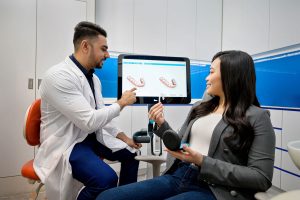
It may be possible to treat an underbite with Invisalign braces alone, or they might be incorporated into a course of treatment that includes underbite surgery too.
To check whether you or your child are a suitable candidate for Invisalign underbite treatment you can take a free Smile Assessment online or book an appointment online with an Invisalign dentist. We always recommend visiting a dentist or orthodontist before starting any treatment.
Tooth extraction
Sometimes, an underbite can be caused by having too many teeth in the lower jaw. If this is the case, your dentist will likely advise you have some teeth removed. Extraction may also be necessary to help braces work effectively, as it frees up space for the rest of the teeth to move into.
Tooth extraction is normally done under local anaesthetic, although general anaesthetic may be used for complicated or multiple extractions. This is a common process which is usually quick, simple and pain-free. The dentist just pushes or twists the tooth to loosen it in the socket, then takes it out. You can read more about the tooth extraction process and recovery in our separate guide.
Underbite jaw surgery
Sometimes the problems with an underbite jaw are quite severe and will require surgery. Underbite jaw surgery can involve a few different things, depending on where the surgeon identifies the problem.
The lower jaw might need to be pushed back and repositioned, or the underbite surgery might focus on the upper jaw. Either way, there will small screws and plates inserted around the bones to make sure that they don’t move back. Occasionally, both the upper and lower jaws will need adjustment.
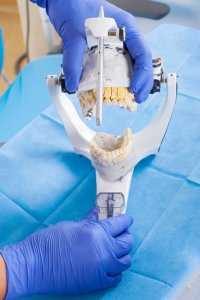
Your surgeon will talk you through what the difference will be in your underbite before and after the surgery. Some common changes include:
- Improved speech
- A different face shape
- Better dental hygiene
- Decreased risk of enamel erosion and tooth decay
This type of surgery isn’t uncommon and you can ask your surgeon or dentist to show you underbite surgery before and after pictures if you are worried about the changes in appearance.
There aren’t normally any scars from underbite surgery because all of the incisions are made inside the mouth. The jaws may be wired following the surgery, or an internal frame placed in the mouth, to make sure the bones heal in the correct position.
Patients are recommended to take 2-4 weeks off school or work after underbite jaw surgery. Treatment usually involves the use of braces before or after surgery, or both.
Underbite treatment summary
Here is a brief overview of the different underbite treatment options:
Underbite correction method | Removable, long term, or permanent? | Treatment timeframe | Ideal age for treatment |
Upper jaw expander | Some devices are permanent, some removable | 1 year of movement, 1 year to hold the position | Before 13 years old |
Reverse pull face mask | Removable | Around 1 year | Before 10 years old |
Chin cap | Removable | Around 1 year | Before 10 years old |
Underbite braces (including Invisalign) | Long term | 1 – 3 years | Once all adult teeth have come though |
Teeth extraction | Permanent | Usually in one visit to the dentist | Once all adult teeth have come though |
Underbite surgery | Permanent | Depends on how complicated the surgery is, recovery time 2-4 weeks | Around 16-18 years old |
Underbite and cleft palate and lip
There is a likelihood that babies born with a cleft palate or cleft lip will also have an underbite, because their upper teeth and jaw bone haven’t developed properly.
Generally, underbite surgery is needed to correct the problem and is unlikely to be much different to the surgery outlined above. Some surgery to fix issues with the cleft may be done at the same time, or it many be carried out separately. Your NHS Cleft Team will walk you through the treatment, and you can seek support from CLAPA too.
Underbite correction on the NHS
Underbite surgery costs nothing through the NHS for children under 18 years old, while for adults the band 3 treatment charge of £282.80 applies. The NHS only covers dental surgery and orthodontic work for adults when deemed medically necessary, which it often is in the case of an underbite.
In any case, your dentist will be able to tell you if you are eligible for NHS treatment. As an adult, NHS underbite surgery costs will cover everything required to treat the condition, including any braces you wear for your underbite before and after your operation. If you have to pay privately, you can find out more about the cost of braces for adults in our separate guide.
Conclusion
Underbites are a lot less common than overbites; only about 5-10% of people will experience this condition, and it really should be treated in every case. This can help improve the patient’s oral health as well as their self esteem. The range of possible treatment options to fix an underbite means there will be a method that suits you or your child.
When a baby has an underbite diagnosed, a treatment plan can be put into place to ensure the least invasive correction technique is used. The success rates of treatment when done early are really high, and even if surgery is needed, it will make a big difference to your child’s oral health and overall wellbeing in the years to come.
Remember that underbite braces needn’t involve conspicuous metal brackets and wires. Removable clear aligners are a popular choice because of their appearance and convenience. Compare our top recommended brands below:
- Up to 80% cheaper than Invisalign
- Buy now, pay later in interest-free instalments.
- Rated 4.5/5 on Trustpilot
- Starting at just 625 for single-arch treatment!
Caspersmile offers a convenient at-home solution for teeth straightening with their clear aligners. You can achieve a perfect smile in 3-5 months, wearing the aligners for 22 hours a day.
Caspersmile’s treatment is overseen by UK-licensed dentists, ensuring professional guidance throughout the process. The treatment starts with an at-home impression kit or a visit to a scan center, followed by a 3D preview of your future smile.
Every treatment comes with free teeth whitening, so you can brighten your smile while you straighten it!
- Hybrid in-office and remote treatment
- In-person visits with your orthodontist for safe, effective treatment
- Treats even complex cases of misalignment
- Various pricing options
Discover the flexibility and effectiveness of Impress Invisible Braces, the hybrid orthodontic solution that blends in-person care with the convenience of remote appointments. Suitable for both kids and adults, Impress offers a range of treatment options designed to cater to various needs, from mild to severe cases of misalignment. With the initial consultation happening in person, you’re assured of a tailored treatment plan that can address even the most complex orthodontic issues.
Impress Treatment Plans:
- Impress Super Light ($6,999): Perfect for mild cases, this plan promises results in up to 3 months, making it the quickest route to a better smile.
- Impress ($4,599): Designed for moderate cases, this option aims to perfect your smile within 4-10 months.
- Impress Plus ($5,599): Tailored for moderate cases requiring a bit more time, this plan spans 11-14 months.
- Impress Advanced ($6,999): The go-to choice for complex cases, offering comprehensive treatment over 11-24 months.
- Teens ($4,599): Specifically designed for teenagers, this plan addresses mild cases within 4-10 months, ensuring a confident smile during those crucial years.
- Impress Kids ($4,599): Offering orthodontic treatment for children, this plan covers a period between 8-18 months, setting the foundation for a lifetime of healthy smiles.
With flexible payment plans available, starting your journey to a perfect smile has never been easier or more accessible. Whether you’re looking for a quick fix or need extensive treatment, Impress Invisible Braces provide a tailored solution that meets your needs and budget. Click below to get started!
- Free retainers and whitening
- Nighttime aligners available
- 0% interest finance options
£1,395£1,295 or £83.33/month
NewSmile is a Canadian company that brought its clear aligners to the UK market in 2022. NewSmile aligners are made from the clearest material and the company offers excellent service at the best price.
They don’t have any physical locations, so you’ll need to purchase an aligner kit to get started. One of their Impression Specialists will guide you through the process on a video call when you’re ready.
NewSmile aligners are very affordable, costing just £1,395 (currently discounted to £1,295). But even better, this price includes whitening foam to use in your aligners, plus your first set of retainers!
Choose their daytime package for treatment in 4-6 months, or nighttime aligners for a more discreet treatment that takes 8-10 months. Both options come with 0% interest payment plans available.
FAQs
How do you fix an underbite in adults?
Underbite correction in adults usually involves braces, perhaps combined with surgery or headgear. Your treatment options will depend on how severe your underbite is.
How much does it cost to fix an underbite?
Underbite treatment is usually available on the NHS free for children. Adults who are eligible for NHS underbite treatment will pay the Band 3 treatment fee. Private treatment costs will vary greatly. That’s because there are so many variables with the treatment itself.
Can you get rid of an underbite without braces?
Not everyone needs braces to fix an underbite, but there aren’t really any natural or DIY treatments. It’s best to visit a dentist for a full assessment of your case. Clear aligners are one way to avoid fixed metal braces, and they are suitable for many mild and moderate cases of underbite.
NHS: How much will I pay for NHS dental treatment? Consulted 16th May 2019.
CLAPA: Jaw surgery. Consulted 17th May 2019.
The Angle Orthodontist: Long-term Efficacy of Reverse Pull Headgear Therapy. Consulted 17th May 2019.





